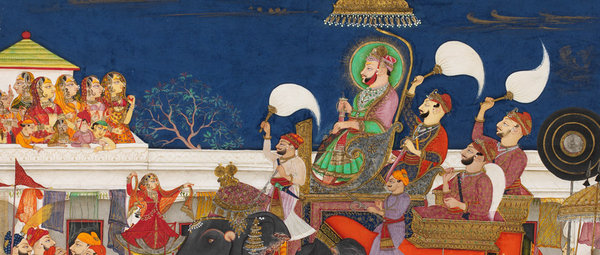Maharaja
dal 9/10/2009 al 16/1/2009
Segnalato da
9/10/2009
Maharaja
Victoria & Albert Museum, London
The word maharaja, literally 'great king', conjures up a vision of splendour and magnificence. The exhibition spans the period from the beginning of the 18th century to the mid-20th century, bringing together over 250 magnificent objects, many being lent from India's royal collections for the first time. It examines the changing role of the maharajas within a social and historical context and reveals how their patronage of the arts, both in India and Europe, resulted in splendid and beautiful objects symbolic of royal status, power and identity.

The V&A’s autumn exhibition, Maharaja: The Splendour of India’s Royal Courts, will
be the first to comprehensively explore the world of the maharajas and their
extraordinarily rich culture. It will bring together over 250 magnificent objects,
many on loan to the UK for the first time from India’s royal collections. The
exhibition will include three thrones, a silver gilt howdah, gem-encrusted weapons,
court paintings, photographs, a Rolls Royce, Indian turban jewels and jewellery
commissioned from Cartier and Van Cleef & Arpels in the 20th century.
The exhibition will cover the period from the 18th century when the great era of the
maharajas began to the end of British rule in 1947. It will show the changing role of
the maharajas in an historical and social context and look at how their patronage
of the arts both in India and Europe resulted in splendid and beautiful commissions
designed to enhance royal status and identity.
Many of the objects have never before been seen in the UK. The royal collections of
Udaipur and Jodhpur are lending several spectacular paintings and objects. The
V&A is reuniting four portraits from the 1930s by Bernard Boutet de Monvel
depicting the elegant Maharaja and Maharani of Indore. One pair depicts them in
Maratha dress and the other in modern Western dress. They will be shown
together on public display for the first time.
Another object on show in the UK for the first time is the Patiala Necklace, part of
the largest single commission that Cartier has ever executed. Completed in 1928
and restored in 2002, this piece of ceremonial jewellery originally contained 2,930
diamonds and weighed almost a thousand carats.
The exhibition will begin with a recreation of an Indian royal procession with a life-
sized model elephant adorned with animal jewellery, textiles and trappings and
surmounted with a silver howdah.
The initial displays will explore ideas of kingship in India and the role of the
maharaja as religious leader, military and political ruler and artistic patron.
Symbols of kingship will include a gaddi (throne) from Udaipur, elaborate turban
jewels, ceremonial swords and a gold ankus (elephant goad) set with diamonds.
A palanquin from Jodhpur used to carry the Maharaja’s wife will provide a rare
glimpse into the lives of ladies at the royal court. The interior of the palanquin
contains original framed prints and cushions.
The next section of the exhibition will focus on the shifts of power and taste in the
18th and early 19th centuries. The disintegration of the Mughal Empire led to a
period of political change in which rival Indian kings laid claim to territory. On
display will be the golden throne of Maharaja Ranjit Singh, who united the warring
factions of the Punjab into a powerful Sikh state, as well as weapons and armour
owned by Tipu Sultan of Mysore and the Maratha ruler Yeshwant Rao Holkar of
Indore.
This period also witnessed the rapid expansion of the territorial interests of the
English East India Company. This led to a new hybrid Anglo-Indian style which will
be seen in objects such as a Spode dinner service and an Egyptian-revival style chair
designed for the Nawab of Awadh.
The exhibition will then look at the grand imperial durbars of the Raj through
large-scale paintings and rare archive film footage. This section will include a
carpet of pearls, rubies, emeralds and diamonds made for the Maharaja of Baroda
and exhibited at the durbar of 1903.
The final section will explore the role of the ‘modern’ maharajas during the Raj and
the increasing European influence on their lives. The exhibition will show how they
were portrayed in both Indian and European style through portraits of the
maharajas and their wives by photographers and artists including Man Ray, Cecil
Beaton and Raja Ravi Varma.
The maharajas’ patronage of European firms resulted in luxurious commissions. On
display will be saris designed by leading French couture houses, a costume by
Madeleine Vionnet, a diamond and emerald necklace designed by Van Cleef &
Arpels, a Rolls Royce and a Louis Vuitton travelling case.
The maharajas were also patrons of the emerging European avant-garde. The
exhibition will include modernist furniture commissioned by the Maharaja of
Indore for his palace in the 1930s and architectural designs for the Umaid Bhawan
palace, an Art Deco style residence commissioned by the Maharaja of Jodhpur.
Mark Jones, Director of the V&A, said: “There has never been an exhibition like this
before, showing the spectacular treasures of the courts of the maharajas. Many of
the objects are leaving India for the first time to come to the V&A. This exhibition will
show that India’s rulers were significant patrons of the arts, in India and the West,
and will tell the fascinating story of the changing role of the maharaja from the early
18th century to the final days of the Raj.”
Press Enquiries
Zoë Franklin or Carrie Rees Tel: +44 (0)20 7942 2502 E-mail: press.office@vam.ac.uk
Opening 10 October 2009
Victoria and Albert Museum
Cromwell Road, London
Exhibition opening times
Daily 10-17.30, Fridays 10-21.30
Exhibitions close 10 minutes prior to museum closing



